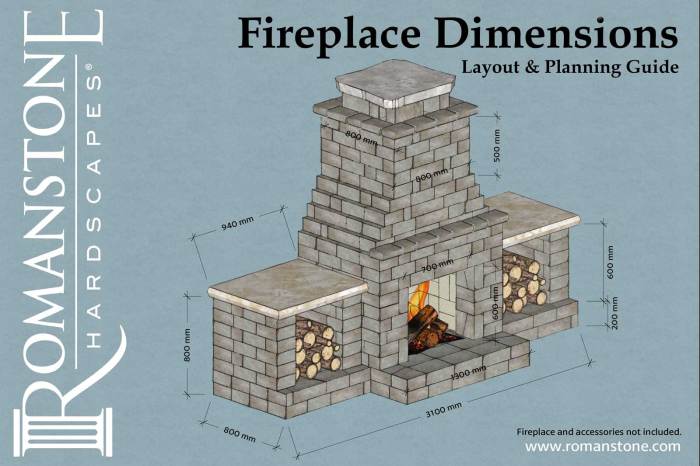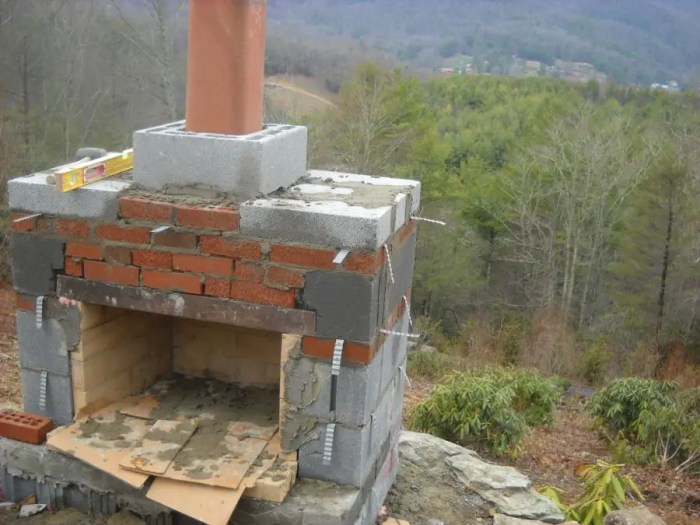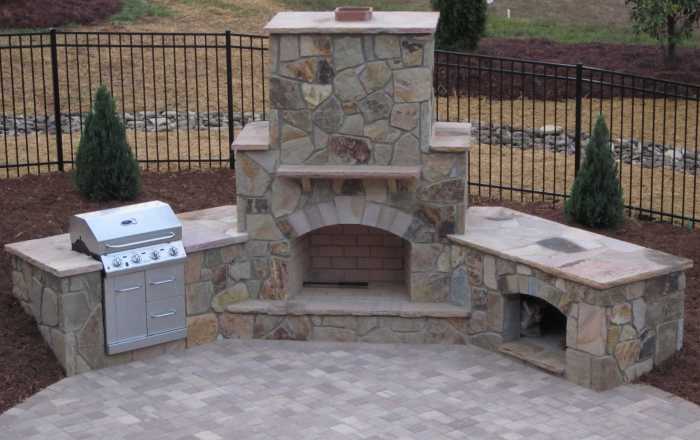Outdoor Fireplace Builders Your Guide to Perfect Fireside – Outdoor Fireplace Builders: Your Guide to Perfect Fireside begins by exploring the diverse world of outdoor fireplaces. From the rustic charm of wood-burning models to the convenience of gas-fueled options, we delve into the features, benefits, and considerations for each type. Understanding your needs, whether it’s a cozy fire pit for intimate gatherings or a grand statement piece for entertaining, is the first step in creating your ideal fireside haven.
This guide provides a comprehensive roadmap, guiding you through every stage of the process, from initial design to long-term maintenance.
We’ll examine crucial factors like material selection, design aesthetics, and proper installation techniques. Furthermore, we’ll help you navigate the process of finding qualified builders, ensuring a smooth and successful project. By the end, you’ll be equipped with the knowledge and confidence to build the perfect outdoor fireplace that enhances your property and provides years of enjoyment.
Defining the Ideal Outdoor Fireplace
Choosing the perfect outdoor fireplace is a significant undertaking, blending aesthetic appeal with practical considerations. The ideal fireplace enhances your outdoor living space, providing warmth, ambiance, and a focal point for gatherings. Careful planning, considering both your needs and the surrounding environment, is key to achieving a truly satisfying result.
Types of Outdoor Fireplaces
Several types of outdoor fireplaces cater to diverse preferences and needs. The choice depends on factors such as budget, desired aesthetic, and available fuel sources. Below is a comparison of common types:
| Type | Fuel Source | Pros | Cons |
|---|---|---|---|
| Wood-Burning Fireplace | Wood Logs | Authentic ambiance, relatively inexpensive fuel (depending on location), produces radiant heat. | Requires regular cleaning and maintenance, produces smoke and ash, may require a permit depending on local regulations, susceptible to weather conditions. |
| Gas Fireplace | Natural Gas or Propane | Clean burning, easy to operate and control, instant ignition, requires less maintenance. | Higher initial cost, requires gas line installation (for natural gas), ongoing fuel costs, may not offer the same ambiance as wood-burning fireplaces. |
| Fire Pit | Wood Logs or Gas | Versatile, portable (in some cases), relatively inexpensive (especially wood-burning versions), creates a casual atmosphere. | Less protection from wind and rain, may not provide as much heat as a fireplace, requires careful placement for safety. |
| Built-in Fireplace | Wood Logs or Gas | Permanent fixture, can be customized to fit any style, provides substantial heat output, can enhance property value. | High initial cost, complex installation process, requires professional planning and construction. |
Key Features to Consider
Selecting an outdoor fireplace involves careful consideration of several key features. The size should be proportional to the space, the material should be durable and weather-resistant, the design should complement the existing landscape, and the functionality should meet your needs. For example, a large stone fireplace might be ideal for a spacious backyard, while a smaller, more compact gas fireplace might suit a smaller patio.
Material choices range from natural stone and brick to more modern options like steel and concrete, each offering a unique aesthetic and level of maintenance. Functionality includes features such as built-in seating, cooking surfaces, or even integrated lighting.
Environmental and Landscaping Considerations
Successful outdoor fireplace integration necessitates careful consideration of the surrounding environment and landscaping. Placement should be mindful of prevailing winds to minimize smoke nuisance, proximity to combustible materials like dry leaves or overhanging branches, and local regulations concerning fire safety and building codes. The fireplace’s design should harmonize with the existing landscaping, complementing existing structures and plant life.
For instance, a rustic stone fireplace would blend seamlessly with a natural, wooded setting, while a sleek, modern design might be more suitable for a contemporary landscape. Proper drainage around the fireplace base is crucial to prevent water damage.
Finding and Vetting Outdoor Fireplace Builders

Source: romanstone.com
Building an outdoor fireplace is a significant investment, requiring careful planning and the selection of a skilled and reliable builder. Finding the right professional can make all the difference in the final product’s quality, safety, and longevity. This section provides a step-by-step guide to help you navigate the process of finding and vetting reputable outdoor fireplace builders in your area.Finding qualified builders begins with thorough research and leveraging available resources.
A multifaceted approach increases your chances of identifying several potential candidates, allowing for comparison and informed decision-making.
Locating Potential Builders
Several avenues exist for identifying potential outdoor fireplace builders. Online directories, such as those offered by Angie’s List or HomeAdvisor, allow you to search by location and read reviews from previous clients. Local home improvement stores often maintain lists of contractors specializing in various home projects, including outdoor fireplaces. Networking with friends, family, and neighbors who have recently had outdoor structures built can yield valuable recommendations.
Designing your perfect outdoor fireplace is a significant undertaking, requiring careful consideration of materials and aesthetics. While planning the ideal fireside ambiance, you might need a break to check out some exciting news; for instance, have you heard the rumors about a new Nintendo Switch game potentially releasing in 2025? Check out the details here: Rumor game Nintendo Switch terbaru rilis tahun 2025.
Once you’ve caught up, let’s get back to crafting that dream outdoor fireplace!
Finally, searching online using relevant s such as “outdoor fireplace builders [your city/state]” can reveal local companies and individual contractors. Comparing the services and pricing from multiple sources is recommended.
Evaluating Builder Qualifications and Experience
Once you’ve compiled a list of potential builders, it’s crucial to assess their qualifications and experience. Verify that each builder holds the necessary licenses and permits to operate legally in your area. Contact your local licensing board to confirm their status and check for any disciplinary actions. Examine their portfolio, paying close attention to the quality of their previous work, focusing on projects similar in scope and design to your vision.
Request references from previous clients and contact them directly to inquire about their experiences, timelines, and overall satisfaction with the builder’s work. Inquire about the builder’s insurance coverage, ensuring they have liability and workers’ compensation insurance to protect you in case of accidents or damages.
Essential Questions for Prospective Builders
Before committing to a builder, a thorough consultation is essential. This consultation should clarify all aspects of the project and ensure alignment on expectations. It’s important to ask about their experience with different fireplace types (wood-burning, gas, etc.), their familiarity with local building codes and regulations, and their detailed process for project management, from initial design to final cleanup.
You should also inquire about their warranty policies, payment schedules, and the materials they intend to use, confirming that they are high-quality and suitable for outdoor use. Additionally, ask about the timeline for completion, contingency plans for potential delays, and the process for addressing any unexpected issues or changes that might arise during construction. A detailed and transparent response to these questions indicates a builder who is organized and prepared to handle your project effectively.
The Design and Planning Process: Outdoor Fireplace Builders Your Guide To Perfect Fireside
Careful planning is paramount to a successful outdoor fireplace project. Detailed plans and blueprints aren’t just helpful; they’re essential for ensuring the fireplace is structurally sound, aesthetically pleasing, and meets all relevant building codes and safety regulations. A well-defined plan minimizes costly mistakes and rework during construction.Thorough planning involves considering various aspects, from the fireplace’s location and size to its materials and style.
This process ensures the final product seamlessly integrates with your outdoor space and complements your home’s architecture. Failing to adequately plan can lead to significant setbacks and increased expenses.
Outdoor Fireplace Design Options
Numerous design options exist for outdoor fireplaces, catering to diverse aesthetic preferences and functional needs. Selecting the right design depends on factors such as available space, desired ambiance, and the overall style of your property. Consider these options when choosing a design for your outdoor fireplace:
- Traditional Masonry Fireplace: This classic style typically uses brick or stone, offering a timeless and rustic appeal. These fireplaces often feature a large firebox and a prominent chimney. Imagine a stately stone fireplace, its rough-hewn texture contrasting beautifully with the surrounding manicured lawn.
- Modern Minimalist Fireplace: Characterized by clean lines and sleek materials like concrete or metal, this style offers a contemporary aesthetic. A minimalist fireplace might be built flush against a wall, emphasizing its geometric form. Picture a clean, rectangular concrete fireplace with a recessed firebox, creating a sophisticated focal point on a modern patio.
- Rustic Wood-Burning Fireplace: This style often incorporates natural materials like reclaimed wood and stone, creating a cozy and inviting atmosphere. These fireplaces frequently feature a more open design, allowing for greater heat distribution. Visualize a charming wood-burning fireplace constructed from stacked river stones, its rustic charm perfectly complementing a woodland setting.
- Fire Pit with Fireplace Features: This design blends the casual ambiance of a fire pit with the structure and containment of a fireplace. It may include a raised stone or brick surround, offering a comfortable seating area around the fire. Imagine a low, circular fire pit with a stone border, creating a relaxed gathering space for family and friends.
Material Selection for Outdoor Fireplaces
The choice of materials significantly impacts the fireplace’s durability, cost, and aesthetic appeal. Each material offers unique properties, influencing both the construction process and the final look. Careful consideration of these factors is vital to making an informed decision.
| Material | Durability | Cost | Aesthetic |
|---|---|---|---|
| Stone (Natural) | Very High; Resistant to weather and fire | High | Rustic, Natural, Varied textures and colors |
| Brick | High; Durable and weather-resistant | Medium | Classic, Versatile, Many colors and patterns available |
| Concrete | High; Strong and durable, but susceptible to cracking if not properly reinforced | Medium-Low | Modern, Minimalist, Can be molded into various shapes |
| Metal (Steel, Corten) | Medium-High; Susceptible to rust unless treated appropriately; Corten steel develops a protective patina | Low-Medium | Modern, Industrial, Sleek and contemporary |
The Construction and Installation Phase
Building an outdoor fireplace is a significant undertaking, requiring careful planning and execution. This phase involves several crucial steps, from laying the foundation to the final finishing touches. Adhering to safety regulations and employing proper techniques ensures a durable and safe structure that will provide years of enjoyment.The construction process typically begins with excavating and preparing a level foundation.
This foundation, often made of concrete, provides a stable base for the entire structure. Next, the fireplace’s structure is built, usually using brick, stone, or concrete blocks. This involves careful laying of materials, ensuring proper mortar application and structural integrity. Chimney construction follows, incorporating a liner to ensure safe exhaust of smoke and gases. Finally, the fireplace is finished, including the application of a fire-resistant sealant and any desired aesthetic features such as a mantel or hearth.
Foundation Preparation and Excavation, Outdoor Fireplace Builders Your Guide to Perfect Fireside
Proper foundation preparation is paramount for a stable and long-lasting outdoor fireplace. This involves excavating the area to the required depth, typically determined by local building codes and soil conditions. The excavated area should be leveled and compacted to provide a firm base for the concrete foundation. For example, a typical foundation might require a depth of 12-18 inches, depending on the size and weight of the fireplace.
The size of the excavation should be slightly larger than the footprint of the fireplace to accommodate the foundation and prevent settling. Reinforcing bars (rebar) are often incorporated into the concrete to further enhance strength and stability. After the concrete is poured, it should be allowed to cure completely before proceeding to the next phase of construction.
Structure Construction and Chimney Installation
Once the foundation has cured, the actual fireplace structure can be built. This usually involves laying bricks, stones, or concrete blocks in a pre-determined pattern. Accurate measurements and careful placement of each unit are crucial to ensure structural stability and prevent cracks or other issues. Mortar is used to bind the materials together, and it’s essential to use a high-quality, fire-resistant mortar suitable for outdoor applications.
The chimney is constructed concurrently with the fireplace structure or shortly thereafter. A properly installed chimney liner is essential for safely venting combustion gases. The liner should extend from the firebox to several feet above the roofline to ensure adequate draft and prevent the buildup of harmful gases. Common chimney materials include clay tiles or stainless steel.
Safety Precautions and Regulations
Building an outdoor fireplace necessitates strict adherence to safety regulations. These regulations vary by location, but typically include requirements for clearances from combustible materials, proper chimney construction, and the use of fire-resistant materials. For instance, minimum clearances are often mandated between the fireplace and nearby structures or vegetation. Building codes often specify requirements for chimney height and diameter to ensure adequate draft.
The use of approved fire-resistant mortar and sealant is crucial to prevent fire hazards. Obtaining necessary permits before commencing construction is also a critical safety precaution. Failure to comply with regulations can lead to significant fines or even legal action.
Final Finishing Touches and Aesthetic Considerations
After the fireplace structure and chimney are completed, the final finishing touches can be applied. This might involve applying a fire-resistant sealant to protect the structure from the elements and enhance its longevity. Aesthetic features, such as a mantel or hearth, can be added to enhance the fireplace’s appearance. The choice of materials and design will depend on personal preference and the overall style of the landscape.
For example, a rustic stone fireplace might be complemented by a natural wood mantel, while a modern concrete fireplace might pair well with a sleek metal hearth. Careful consideration should be given to the selection of materials to ensure they are compatible with the fireplace’s structure and the surrounding environment.
Visual Representation of a Typical Outdoor Fireplace Installation
Imagine a team of builders starting with a marked area on a level backyard. They excavate a rectangular pit, roughly 2 feet deeper and wider than the planned fireplace. They then pour a reinforced concrete foundation, leaving it to cure for several days. Once cured, they begin laying firebricks, creating the firebox and the surrounding structure. As the structure rises, a stainless steel chimney liner is carefully inserted and extended upwards.
More bricks are laid to form the chimney, ensuring proper venting. Finally, a cap is placed on top of the chimney, and a fire-resistant sealant is applied to the entire structure. The final touch might involve adding a stone or brick hearth and a simple wooden mantel. The entire process, from excavation to finishing, might take several days or even weeks, depending on the size and complexity of the fireplace.
Post-Installation Care and Maintenance

Source: casepractice.ro
Your beautiful new outdoor fireplace is a significant investment, and proper care will ensure it remains a focal point of your outdoor space for years to come. Regular maintenance not only enhances its aesthetic appeal but also significantly extends its lifespan and prevents potential safety hazards. This section details crucial post-installation care and maintenance practices for various outdoor fireplace types.Regular cleaning and inspection are paramount for maintaining the structural integrity and optimal functionality of your outdoor fireplace.
Neglecting these tasks can lead to issues like chimney blockages, structural damage from moisture, and even fire hazards. A proactive approach minimizes these risks and maximizes the enjoyment of your investment.
Designing your perfect outdoor fireplace requires careful planning, from choosing the right materials to ensuring proper ventilation. However, securely managing the associated smart home applications is equally crucial; for example, consider the importance of Keamanan aplikasi seluler to protect your system from unauthorized access. Ultimately, a safe and functional fireplace enhances your outdoor living space, providing warmth and ambiance for years to come.
Cleaning and Inspection Procedures
Thorough cleaning should be performed after each use, while more extensive inspections are recommended seasonally or annually, depending on usage frequency and climate. After each use, allow the fireplace to cool completely before attempting any cleaning. Remove ashes from the firebox using a sturdy metal ash shovel and dustpan, ensuring no embers remain. Brush down the interior walls of the firebox with a wire brush to remove any soot buildup.
For fireplaces with glass doors, clean the glass with a suitable glass cleaner, avoiding abrasive materials. Seasonal inspections should include checking for cracks in the firebox, chimney, and surrounding masonry. Look for any signs of deterioration or damage to the mortar. A visual inspection of the chimney from the top (if safely accessible) can reveal potential blockages or damage.
Designing the perfect outdoor fireplace requires careful planning, from choosing the right materials to ensuring proper ventilation. Understanding market trends is key to any successful project, much like anticipating growth in other sectors; for example, consider the promising outlook for the Indonesian gaming industry, as detailed in this insightful report: Prospek industri game Indonesia di tahun 2025.
Ultimately, creating a stunning outdoor fireplace, like building a successful business, hinges on thorough research and strategic execution.
If any significant issues are found, contact a qualified professional for repair or assessment.
Preventing Chimney Blockages
Chimney blockages are a common problem that can lead to dangerous situations, including smoke backdrafting and chimney fires. Regular cleaning is the best preventative measure. Creosote buildup, a byproduct of incomplete combustion, is highly flammable and a major cause of chimney fires. The frequency of chimney sweeping depends on factors such as fuel type and usage frequency; however, at a minimum, annual inspections by a certified chimney sweep are recommended.
In addition to regular cleaning, ensure that the chimney cap is securely in place and free from obstructions like leaves, nests, or debris. Proper ventilation around the fireplace also helps to prevent issues related to smoke and creosote buildup. Consider installing a chimney liner if your fireplace is older and lacks one, as this provides a smoother path for smoke and reduces creosote accumulation.
Addressing Structural Damage
Structural damage can range from minor cracks in the mortar to more significant issues like foundation settling or damage to the chimney. Regular inspections are crucial for early detection. Minor cracks in mortar can often be repaired using a suitable mortar patching compound. However, larger cracks or any signs of structural instability require the attention of a qualified mason or structural engineer.
Moisture damage is a significant contributor to structural problems. Ensure that the fireplace is adequately protected from rain and snow. A proper waterproof cap on the chimney is essential. Consider installing a cover or shelter to protect the fireplace from the elements when not in use, especially during periods of prolonged rain or snow. Addressing issues promptly will prevent minor problems from escalating into costly repairs.
Maintenance Schedule Examples
A simple maintenance schedule can help you stay on top of your outdoor fireplace care. This schedule is a guideline and should be adjusted based on your fireplace type, frequency of use, and climate.
| Task | Frequency |
|---|---|
| Ash removal | After each use |
| Interior cleaning (firebox, glass) | After each use |
| Visual inspection for cracks and damage | Monthly |
| Chimney inspection (by certified sweep) | Annually |
| Mortar repair (if needed) | As needed |
| Exterior cleaning (if applicable) | Twice yearly |
Budgeting and Cost Considerations
Building an outdoor fireplace is a significant investment, and understanding the associated costs is crucial for successful project planning. Several factors contribute to the final price, ranging from material choices to regional labor rates and necessary permits. Careful budgeting ensures a smooth process and prevents unexpected financial strain.Factors influencing the overall cost are multifaceted. Material selection significantly impacts the budget.
High-end materials like natural stone, brick from specific quarries, or custom-designed metalwork will naturally increase expenses compared to more readily available and less expensive options such as concrete blocks or standard brick. The complexity of the design also plays a role; intricate designs with multiple features, such as built-in seating or elaborate chimney structures, will require more labor and specialized skills, leading to higher costs.
Location and accessibility of the build site also factor in; difficult-to-reach locations may require specialized equipment and additional labor, thus impacting the overall cost. Finally, obtaining necessary permits and inspections adds to the overall expense, varying based on local regulations and the scope of the project.
Sample Budget Breakdown for a Mid-Range Outdoor Fireplace
This sample budget Artikels a mid-range outdoor fireplace project, offering a realistic cost estimation. It’s important to remember that these figures are estimates and can vary significantly depending on location and specific choices.
| Item | Cost Estimate |
|---|---|
| Materials (brick, mortar, firebox, etc.) | $3,000 – $5,000 |
| Labor (skilled mason, foundation work) | $4,000 – $7,000 |
| Permits and Inspections | $500 – $1,000 |
| Contingency (for unforeseen expenses) | $1,000 – $2,000 |
| Total Estimated Cost | $8,500 – $15,000 |
This budget assumes a relatively straightforward design using standard materials and a reasonable project timeline. More elaborate designs or the use of premium materials will increase costs considerably.
Financing Options for Outdoor Fireplace Projects
For those seeking to spread the cost of their outdoor fireplace project, several financing options exist. Home equity loans or lines of credit can leverage existing home equity to fund the project. These options often offer favorable interest rates compared to personal loans. Personal loans from banks or credit unions provide another avenue, offering varying terms and interest rates depending on creditworthiness.
Finally, some contractors may offer financing plans, allowing customers to pay for the project over time through monthly installments. It’s essential to compare interest rates, terms, and fees across various options to choose the most suitable financing solution for individual circumstances. Thoroughly reviewing loan agreements and understanding repayment schedules is crucial before committing to any financing option.
Enjoying Your New Outdoor Fireplace
Investing in an outdoor fireplace is about more than just adding a focal point to your backyard; it’s about creating a space for relaxation, connection, and memorable moments. Transforming your outdoor area into a warm and inviting haven requires thoughtful consideration of ambiance, comfort, and safety. This section will guide you on maximizing your enjoyment of your new fireplace.
The key to a truly enjoyable outdoor fireplace experience lies in creating a welcoming atmosphere that encourages relaxation and socialization. Consider your fireplace as the heart of your outdoor living space, and design the surrounding area to complement its warmth and charm.
Creating a Welcoming Atmosphere
A successful outdoor fireplace area goes beyond just the fireplace itself. Careful consideration of seating, lighting, and decorative elements contributes significantly to the overall ambiance. Soft, comfortable seating arranged around the fireplace encourages conversation and relaxation. Strategic placement of lighting, both ambient and task lighting, adds depth and warmth, extending the usability of the space into the evening.
Designing the perfect outdoor fireplace requires careful planning, from choosing the right materials to ensuring optimal functionality. Consider the immersive experience – imagine designing your fireplace in virtual reality, a technology rapidly advancing as shown in this article on the future of gaming with VR and AR: Perkembangan VR dan AR dalam dunia game tahun 2025.
Such advancements could soon revolutionize even home design, allowing for incredibly detailed and interactive visualizations before construction begins on your dream outdoor fireplace.
The use of textures, such as soft rugs or throws, adds a layer of comfort and visual interest, making the space feel more inviting and homely. Consider incorporating natural elements like plants and water features to create a serene and tranquil setting.
Outdoor Fireplace Accessories
The right accessories can elevate your outdoor fireplace experience from enjoyable to exceptional. Consider these additions to enhance both functionality and aesthetics:
- Seating: Comfortable and weather-resistant seating options, such as wicker chairs, cushioned benches, or even outdoor sofas, are essential. Choose materials that are durable and easy to clean.
- Lighting: String lights, lanterns, or pathway lighting create a magical ambiance, extending the usability of the space into the evening. Consider solar-powered options for convenience.
- Fire Tools: A sturdy poker, shovel, and brush set are not only practical for managing the fire but also add a touch of rustic charm. Opt for high-quality tools made from durable materials.
- Outdoor Rugs: A weather-resistant rug defines the seating area and adds warmth and texture underfoot. Choose a rug that complements the overall aesthetic of your outdoor space.
- Side Tables: Small, weather-resistant side tables provide convenient surfaces for drinks, snacks, and other items. Look for tables with built-in cup holders or shelves for added functionality.
Outdoor Fireplace Safety Precautions
Safety should always be a top priority when using an outdoor fireplace. Following these precautions will ensure a safe and enjoyable experience for everyone:
- Never leave a fire unattended: Always supervise the fire and never leave it unattended, especially when children or pets are present.
- Keep a safe distance: Maintain a safe distance from the fire to avoid burns or accidental contact with hot embers.
- Use proper fire tools: Use the appropriate fire tools to manage the fire safely and avoid direct contact with flames or hot embers.
- Keep flammable materials away: Keep flammable materials, such as dry leaves, branches, and furniture, away from the fireplace to prevent accidental fires.
- Have a fire extinguisher nearby: Keep a fire extinguisher readily available in case of a fire emergency. Ensure everyone knows how to use it.
- Check local fire regulations: Be aware of and comply with all local fire regulations and restrictions regarding outdoor fireplaces.
Summary

Source: hirerush.com
Creating the perfect outdoor fireplace is a rewarding journey that blends careful planning, skilled craftsmanship, and a vision for your ideal outdoor space. This guide has walked you through each essential step, from selecting the right type of fireplace and finding a reputable builder to understanding the design process, construction, and long-term maintenance. Remember, the ultimate goal is to build a structure that not only meets your functional needs but also enhances the beauty and comfort of your home.
Enjoy the warmth, ambiance, and countless memories that your new outdoor fireplace will bring for years to come.
Questions Often Asked
What permits are typically required for outdoor fireplace construction?
Permits vary by location. Check with your local building department for specific requirements, which may include zoning permits, building permits, and potentially fire safety inspections.
How long does the entire outdoor fireplace construction process usually take?
The timeline depends on factors like the fireplace’s complexity, material choices, and weather conditions. Expect anywhere from a few weeks to several months for completion.
What is the average lifespan of an outdoor fireplace?
With proper maintenance, an outdoor fireplace can last for decades. The lifespan depends on the materials used and the level of exposure to the elements.
Can I build an outdoor fireplace myself?
While possible for simpler designs, building an outdoor fireplace is a complex project that often requires specialized skills and knowledge. Hiring a professional is recommended for safety and quality.
What are some creative ways to incorporate my outdoor fireplace into my landscaping?
Consider building it into a retaining wall, integrating it with a patio design, or surrounding it with strategically placed plants and lighting to create a visually appealing and functional space.


